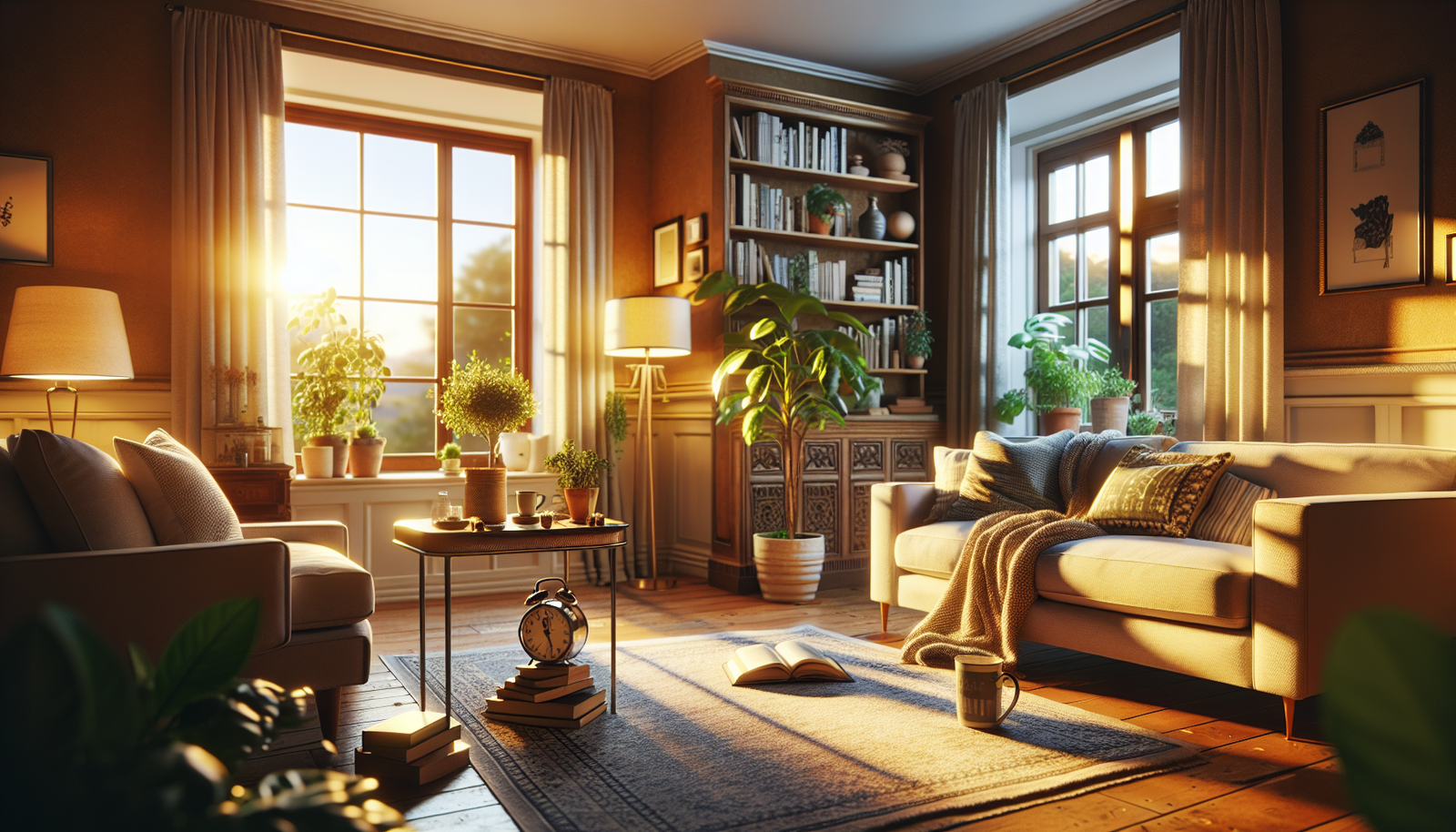Tips for Creating a Peaceful Home Environment
Tips for Creating a Peaceful Home Environment
Creating a peaceful home environment is essential for promoting mental well-being and fostering relaxation. A serene space can significantly enhance your mood and productivity. Below are detailed tips to help you achieve the tranquil oasis you desire.
1. Declutter Your Space
Prioritize Minimalism
Start by decluttering your space. Remove items that no longer serve a purpose or bring joy. Minimalism is key; a tidy environment reduces stress and creates mental clarity.
Organize Your Belongings
Designate specific spaces for items. Use baskets, shelves, and containers to keep things organized. Label boxes for easy access and understanding.
Regular Maintenance
Set aside time weekly to review your belongings. Regular decluttering ensures that your space remains calm and free from chaos.
2. Choose Soothing Colors
Calming Color Palette
When painting your home, opt for soft, calming colors like blues, greens, or neutrals. These colors are known to evoke tranquility.
Accents and Decor
Incorporate accents such as cushions or artworks in subtle hues. Ensure that your decor complements the overall soothing theme.
Seasonal Updates
Change the color palette slightly with the seasons. Use warmer tones in winter and cooler hues in summer. This keeps the environment refreshing and harmonious.
3. Incorporate Nature
Indoor Plants
Introducing indoor plants can purify the air and enhance your mood. Consider plants like spider plants, peace lilies, and snake plants for low maintenance.
Natural Light
Maximize natural light by using sheer curtains or strategically placing mirrors. Sunlight has proven benefits, such as boosting serotonin levels.
Outdoor Connection
Create a connection to nature by placing outdoor furniture in a garden or balcony. Enjoying dinner outside or reading can create a peaceful sanctuary.
4. Use Aromatherapy
Essential Oils
Utilize essential oils for relaxation. Lavender, chamomile, and sandalwood are excellent for calming the mind. Use a diffuser or oil burners for consistent release.
Scented Candles
Choose soy or beeswax candles with soothing scents. Burning candles regularly can create a warm atmosphere.
Scented Decorations
Incorporate scented sachets in drawers or closets. Ensure that these fragrances align with the calming theme of your home.
5. Create Separate Areas for Different Activities
Designate Spaces
Set aside distinct areas for work, relaxation, and recreation. This delineation can foster focus and promote leisure.
Cozy Nook
If possible, create a cozy reading nook with comfortable seating, bookshelves, and soft lighting. This can be your go-to place for unwinding.
Organized Home Office
Ensure your home office is organized and away from distractions. Having a separate workspace helps maintain a healthy work-life balance.
6. Control Noise Levels
Soundproofing
Consider soundproofing techniques like adding rugs or curtains to absorb noise. Plus, fixtures, foam panels, or acoustic tiles can reduce ambient sounds.
Calming Sounds
Play soft music, nature sounds, or white noise to mask disruptive sounds. Creating a soothing auditory backdrop can enhance relaxation.
Quiet Zones
Establish quiet zones in your home, such as a meditation corner or a library. Ensure these areas are free from electronic devices.
7. Optimize Lighting
Soft Lighting
Use soft, warm lighting to create an inviting atmosphere. Opt for dimmers to adjust the brightness according to your needs.
Layered Lighting
Incorporate layered lighting solutions, combining ambient, task, and accent lighting. This ensures flexibility and comfort in the setting.
Avoid Harsh Lights
Minimize the use of harsh fluorescent lights which can lead to discomfort. Opt for softer bulbs that create a welcoming ambiance.
8. Personalize Your Space
Meaningful Decor
Incorporate decor that reflects your personality and interests. Family photos, travel memorabilia, and art that resonates with you help create a comforting atmosphere.
Sentimental Items
Display objects that hold sentimental value—these can bring back positive memories and create a sense of belonging.
Change with Seasons
Rotate decor seasonally to keep your space feeling fresh. Add seasonal elements like colorful decorations or themed items.
9. Incorporate Mindfulness Practices
Meditation Space
Designate an area for meditation or yoga. This space should be quiet, serene, and free from distractions, equipped with mats and cushions.
Daily Practices
Integrate short mindfulness exercises daily. Simple breathing techniques can help maintain a peaceful mindset.
Journaling
Consider a journaling space. Writing down thoughts and feelings can help clear your mind and promote emotional health.
10. Foster Connection
Family Gatherings
Encourage regular family gatherings. Shared meals and activities strengthen relationships and contribute to a peaceful environment.
Create Rituals
Develop nightly or weekly rituals, such as family movie nights or game evenings, that foster connection and happiness.
Open Communication
Maintain open lines of communication with all household members. Address conflicts quickly and respectfully to sustain a peaceful atmosphere.
11. Establish Routines
Daily Patterns
Create daily routines for household chores, meals, and activities. Routines offer predictability—reducing chaos and stress.
Self-Care Rituals
Incorporate self-care into your routines. Designate time for relaxation, skincare, or hobbies to maintain a peaceful mindset.
Family Involvement
Involve family members in establishing routines. This encourages accountability and ownership of the home’s atmosphere.
12. Limit Technology Use
Create Tech-Free Zones
Designate areas in your home to be tech-free. This encourages face-to-face interaction and mindfulness.
Regular Breaks
Set daily or weekly tech-free breaks, especially during meals or before bedtime, to promote family bonding and relaxation.
Digital Decluttering
Regularly assess your digital spaces as well. Organize files and delete unnecessary clutter to create a more streamlined digital life.
13. Engage Your Senses
Textures
Use a variety of textures in your space. Soft textiles, rough woods, and smooth ceramics create visual interest and sensory comfort.
Sounds of Nature
Incorporate natural elements that produce calming sounds, like water fountains or wind chimes. These can elevate the peacefulness of your home environment.
Tasteful Experiences
Plan gatherings with healthy meals that invigorate the senses. Sharing and enjoying food can be a grounding experience for everyone.
14. Cultivate a Positive Mindset
Affirmations
Use positive affirmations around your home. Place them where you can see and read them daily to boost your mood.
Gratitude Practice
Encourage a culture of gratitude—express appreciation for your space and those who share it. This fosters a positive living environment.
Surroundings Impact
Remain conscious of how your surroundings impact your mood and productivity. Adjust your environment accordingly to promote positivity.
15. Prioritize Comfort
Comfortable Furniture
Invest in comfortable furnishings for living spaces. Sofas, chairs, and bedding should promote relaxation and well-being.
Climate Control
Maintain a comfortable temperature throughout your home. Utilize heating and cooling solutions that suit different preferences and seasons.
Cozy Details
Incorporate cozy details, like soft blankets, plush pillows, and cozy rugs. These make your environment inviting and comfortable.
16. Embrace Simplicity
Simplify Decor
Avoid overcrowding your space with too much decor. Aim for a few impactful pieces that resonate with your sensibilities.
Simple Meals
Prepare simple meals that nourish without stress. This creates a calm, efficient cooking experience and promotes healthy eating.
Streamlined Processes
Simplify your daily tasks and processes. Streamlining routines reduces stress and promotes a more peaceful home life.
17. Seek Professional Help if Needed
Interior Designers
If redesigning your home feels overwhelming, consider hiring an interior designer. They can create a personalized plan that reflects your vision for peace.
Mental Health Professionals
If personal or family issues arise that disrupt the peace in your home, seeking a mental health professional can be beneficial for everyone involved.
Family Mediators
If conflicts persist, consider engaging a family mediator. These professionals can facilitate open communication and resolve underlying issues.
18. Enjoy Personal Time
Recharge Alone
Ensure everyone in your household has opportunities for personal time. Solo activities can recharge emotional and mental energy.
Pursue Hobbies
Engage in hobbies that bring joy—whether painting, gardening, or crafting. This personal joy contributes to overall household peace.
Time Management
Practice effective time management to ensure that there is time for personal interests amidst the busy life at home.
19. Plan Outdoor Activities
Get Fresh Air
Plan regular outdoor activities, such as walks, picnics, or gardening. Outdoor experiences enhance well-being and create shared memories.
Connection with Nature
Foster a connection with the local environment by exploring nature trails or parks. Nature influences mood positively.
Seasonal Fun
Adjust outdoor activities according to the seasons. For example, backyard barbecues in summer and leaves raking in autumn keep the excitement going.
20. Maintain Hygiene
Regular Cleaning
Establish a regular cleaning schedule to maintain a tidy and hygienic home environment. Clean spaces can significantly influence mental well-being.
Organize Cleaning Supplies
Keep all cleaning supplies well-organized and easily accessible. This makes maintenance more manageable and less daunting.
Natural Cleaning Products
Use natural cleaning alternatives for a healthier environment. Many store-bought products contain chemicals that can affect mental clarity.
Creating a peaceful home environment takes intention, commitment, and regular effort, but the benefits of tranquility and harmony within your space are immeasurable. Implementing these thoughtful practices can eventually lead to a sanctuary that nourishes your spirit and fosters happiness.








